TCP/IPv4 Settings
This section describes the procedure for setting TCP/IPv4 using the control panel. After specifying the settings for TCP/IPv4, follow the procedure in "Settings Common to TCP/IPv4 and TCP/IPv6" to specify the required settings, and the procedure in "Confirming TCP/IPv4 Settings (PING Command)" to check whether the network settings are correct. If the settings for TCP/IPv6 are already specified and you have finished specifying the settings common to TCP/IPv4 and TCP/IPv6, only check the network settings after completing this procedure.
If you want to use IPv6 communications at the same time, follow the procedure in "TCP/IPv6 Settings" to specify the required settings, and the procedure in "Confirming TCP/IPv6 Settings (PING Command)" to confirm the settings.
1.
Press  .
.
 .
.2.
Press [Preferences] → [Network].
3.
Press [TCP/IP Settings] → [IPv4 Settings].

4.
Press [Use IPv4] for [IPv4 Settings] → press [On] → [OK].
If you select [Off] for <Use IPv4>, IPv4 networks cannot be used, regardless of the settings specified for IPv4 on the Settings/Registration screen. The ARP (Address Resolution Protocol) table is also disabled.
5.
Press [IP Address Settings] for [IPv4 Settings] → specify the following items → press [OK].
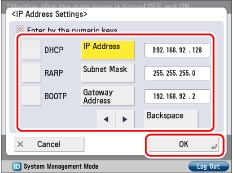
Using a fixed IP address:
Press [IP Address] → enter the IP address.
Press [Subnet Mask] → enter the subnet mask.
Press [Gateway Address] → enter the gateway address.
Select 'Off' for [DHCP], [RARP], and [BOOTP].
|
IMPORTANT
|
|
It takes about two minutes to check whether the DHCP, BOOTP, or RARP settings can be used. If you do not plan to use one of these settings, it is recommended that you turn them off.
|
Obtaining automatically an IP address:
Select 'On' for only one of [DHCP], [RARP], and [BOOTP].
Press [IP Address] → enter the IP address.
Press [Subnet Mask] → enter the subnet mask.
Press [Gateway Address] → enter the gateway address.
|
IMPORTANT
|
|
If this information cannot be obtained via DHCP, RARP, or BOOTP after you restart the machine, enter the IP address, subnet mask, and gateway address to use the settings entered in this step.
|
|
NOTE
|
|
If the machine is restarted after DHCP, BOOTP, or RARP settings are specified, the TCP/IP Settings screen displays the IP address setting values obtained from the DHCP, BOOTP, or RARP server. (If the IP address, host name, and domain name have been previously set, these will be overwritten by the setting values obtained from DHCP, BOOTP, or RARP.)
If you use DHCP without the DNS dynamic update function, it is recommended that an identical IP address be assigned to the machine at all times. (If the IP address is not identical, the host name for the machine will not correspond to the IP address.)
|
6.
Press [OK] → [Up].
7.
Press [DNS Settings] for [TCP/IP Settings] → press [DNS Server Address Settings].
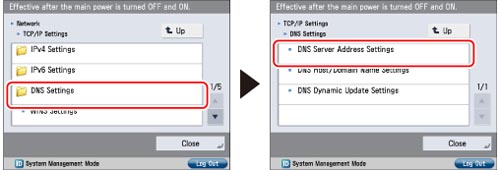
8.
Specify the following settings in <IPv4> → press [OK].
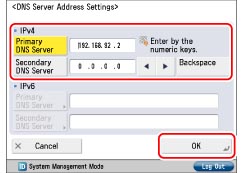
If you want to use dynamic DNS updating, enter the IPv4 address of the DNS server in [Primary DNS Server].
If you do not want to set up a secondary DNS server, enter <0.0.0.0>.
|
IMPORTANT
|
|
If you set [BOOTP] or [DHCP] to 'On' in step 5, the IP address of a DNS server you set manually will be overwritten.
|
9.
Press [DNS Host/Domain Name Settings] for [DNS Settings] → specify the following items in <IPv4> → press [OK].
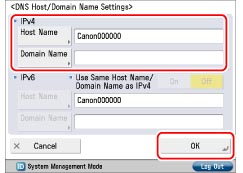
If you want to use dynamic DNS updating, it is necessary to set a host name and domain name.
Host Name: Press [Host Name] → enter the name of the machine → press [OK].
Domain Name: Press [Domain Name] → enter the name of the network domain the machine belongs to → press [OK].
Domain Name: Press [Domain Name] → enter the name of the network domain the machine belongs to → press [OK].
|
IMPORTANT
|
|
If you set [BOOTP] or [DHCP] to 'On' in step 5, the host name and domain name you set manually will be overwritten.
|
10.
Press [DNS Dynamic Update Settings] for [DNS Settings] → specify the following items in <IPv4> → press [OK].
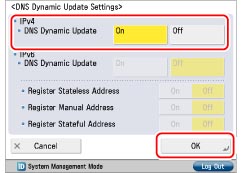
If you press [On] for <DNS Dynamic Update>, you can automatically register the IPv4 address, host name, and domain name set for the machine in the DNS server using dynamic DNS updating. A dynamic DNS server is required for using dynamic DNS updating.
|
NOTE
|
|
If you have a DHCP server running Windows 2000 Server that uses the DHCP service and want to register the machine's DNS record, configure the following settings in the DHCP server:
In the DHCP server, right-click the [Scope] icon → click [Properties]. In the [DNS] sheet of the displayed dialog box, select [Automatically update DHCP client information in DNS] → [Update DNS only if DHCP client requests].
If you have a DHCP server running Windows Server 2003 that uses the DHCP service and want to register the machine's DNS record, configure the following settings in the DHCP server:
In the DHCP server, right-click the [Scope] icon → click [Properties]. In the [DNS] sheet of the displayed dialog box, select [Enable DNS dynamic updates according to the settings below] → [Dynamically update DNS A and PTR records only if requested by the DHCP clients].
In the Active Directory environment, right-click the icon of the DHCP server you are using → select [Properties]. In the [Advanced] sheet of the displayed dialog box, click [Credentials]. In the [DNS dynamic update credentials] dialog box, enter the user name, domain, and password for the Active Directory.
If you have a DHCPv4 server running Windows Server 2008 that uses the DHCPv4 service and want to register the machine's DNS record, configure the following settings in the DHCPv4 server:
In the DHCPv4 server, right-click the [Scope] icon → click [Properties]. In the [DNS] sheet of the displayed dialog box, select [Enable DNS dynamic updates according to the settings below] → [Dynamically update DNS A and PTR records only if requested by the DHCP clients].
In the Active Directory environment, right-click the icon of the DHCPv4 server you are using → select [Properties]. In the [Advanced] sheet of the displayed dialog box, click [Credentials]. In the [DNS dynamic update credentials] dialog box, enter the user name, domain, and password for the Active Directory.
|
11.
Press [OK] → [Up] → [Up].
12.
Press [Firewall Settings] for [Network] → press [IPv4 Address Filter].
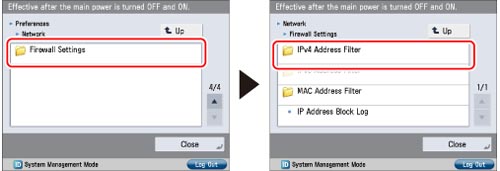
13.
Specify the following settings → press [OK].
By specifying the settings described below, you can filter received packets and transmitted packets using IPv4 addresses and improve security when sending and receiving data between your computer and the machine. The possibility of a third person gaining unauthorized access can be reduced by configuring the settings for [IPv4 Address Filter] in accordance with the environment you are using.
If you want to deny data transmission/reception between a computer with a specified IPv4 address and the machine, set the default policy for the transmission or reception filter so as to allow transmission/reception, and enter the IPv4 address to be denied. Data transmission/reception between the computer having the specified IPv4 address and the machine will be disabled. Also, the Remote UI cannot be used, and information regarding the machine cannot be displayed or set using a utility on the computer whose IPv4 address has been specified. If you want to enable data transmission/reception only with a computer having a specified IPv4 address, set the default policy for the transmission or reception filter so as to deny transmission/reception, and enter the IPv4 address to be allowed. Data transmission/reception will be enabled only between the computer having the specified IPv4 address and the machine. The Remote UI can be used, and information regarding the machine can be displayed and set using a utility only on the computer whose IPv4 address has been specified.
If you want to deny transmission/reception of data with the computer having the specified IPv4 address:
Press [TX Filter] or [RX Filter] for [IPv4 Address Filter] → set <Use Filter> to 'On' → press [Allow] for <Default Policy>.
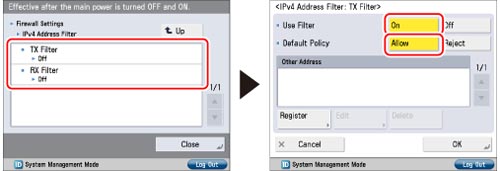
Press [Register] → set the IPv4 address or IPv4 address prefix for which data transmission/reception is to be denied → press [OK].
To specify a single IPv4 address: Press [Single Address] → enter an IPv4 address.
To specify a range of IPv4 addresses: Press [Address Range] → press [First Address] → enter the first IPv4 address → press [Last Address] → specify the last IPv4 address.
To set the IPv4 address prefix: Press [Specify Prefix] → press [Address] → enter the IPv4 address prefix → press [Prefix Length] → enter the prefix length.
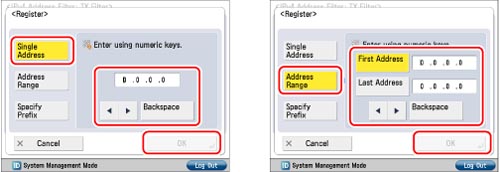
|
NOTE
|
|
If data transmission/reception is attempted between the device having the IPv4 address specified in this procedure and the machine, a block log will be generated. To display the block log, see "Checking the Block Log."
|
If you want to allow transmission/reception of data only with the computer having the specified IPv4 address:
Press [TX Filter] or [RX Filter] for [IPv4 Address Filter] → set <Use Filter> to 'On' → press [Reject] for <Default Policy>.
Press [Register] → set the IPv4 address or IPv4 address prefix for which data transmission/reception is to be allowed → press [OK].
To specify a single IPv4 address: Press [Single Address] → enter an IPv4 address.
To specify a range of IPv4 addresses: Press [Address Range] → press [First Address] → enter the first IPv4 address → press [Last Address] → specify the last IPv4 address.
To set the IPv4 address prefix: Press [Specify Prefix] → press [Address] → enter the IPv4 address prefix → press [Prefix Length] → enter the prefix length.
If you do not want to restrict data transmission/reception:
Press [TX Filter] or [RX Filter] for [IPv4 Address Filter] → set <Use Filter> to 'Off'.
|
IMPORTANT
|
|
You can register up to 16 IPv4 addresses, IPv4 address ranges, or IPv4 address prefixes.
The value of [First Address] should be less than or equal to that of [Last Address].
If the usage of a protocol or print application is not permitted on your device, it cannot be used even after settings in [Firewall Settings] have been changed; on your device, configure the settings to permit the protocol or print application.
If you enter '255' in [Prefix Length], no IPv4 addresses will be set.
If you enter '0' in [Prefix Length], all IPv4 addresses will be set.
|